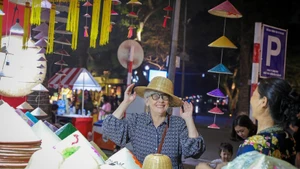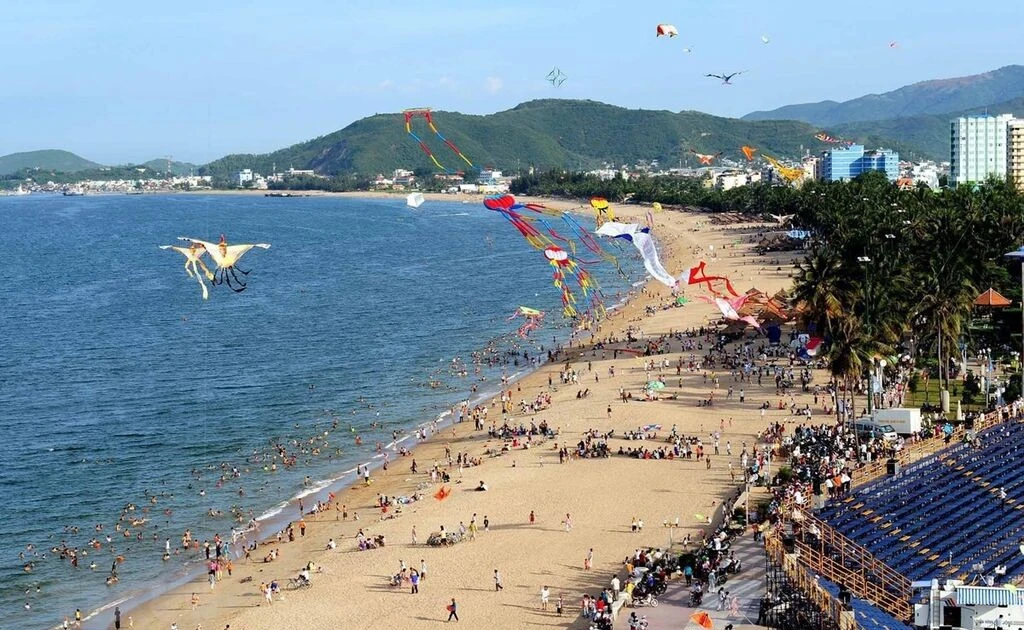Many investment resources have been mobilised to build new and diverse destinations and tourism products in rural areas, initially achieving impressive results, attracting tourists, creating jobs, increasing income for people, and contributing to economic growth.
In addition to the world cultural heritages and a rich system of intangible cultural heritages and relics, attracting tourists and beautiful beaches, Quang Nam has many villages and craft villages that still retain long-standing traditional cultures such as: Kim Bong Carpentry Village, Triem Tay Village, Thanh Ha Pottery Village, Tra Que Vegetable Village, Lam Yen Drum Village, and the brocade weaving village of the Co Tu people.
This place is also a land that contains a very rich culinary culture with many famous dishes such as: My Quang (Quang noodles), which was recognised as National intangible cultural heritage; Cau Mong grilled veal; cao lau (rice noodles); Hoi An gai leaf cake; and Cu Lao Cham bird's nest.
Associating development with conservation and promotion of heritage values
Quang Nam has 128 rural agricultural tourism spots; Among them, there are many effective tourist destinations such as: Thanh Ha Pottery Village, Tra Que Vegetable Village, Bay Mau Cam Thanh Coconut Forest, Kim Bong Carpentry Village, Cu Lao Cham, and Tan Thanh Fishing Village (Hoi An).
According to a survey, it is estimated that more than 30% of tourists coming to Quang Nam experience agricultural and rural tourism products. The most exemplary is the Bay Mau Coconut Forest tourist destination, Cam Thanh Commune, Hoi An, which attracted nearly 1 million visitors in 2023, with revenue of more than 27 billion VND from ticket sales.
Director of the Department of Culture, Sports and Tourism Nguyen Thanh Hong said that in order to unleash the potential, in recent times, Quang Nam has issued many policies, plans, infrastructure investments, promotion, and support for tourism development.
In 2021, the Provincial Party Committee issued Resolution No. 13-NQ/TU on developing trade and tourism in Quang Nam Province until 2025, with a vision to 2030; a plan to develop green tourism until 2025 and was the first province in the country to announce a set of green tourism criteria.
Quang Nam has built a sustainable tourism environment, "plastic waste-free" tourism. In Hoi An City, the government has launched a programme to not use plastic bags in Cu Lao Cham since 2009; many hotels and accommodation establishments in Hoi An use glass bottled water instead of plastic bottles.
To date, the province has 33 tourism businesses in the fields of accommodation, tourist attractions, and travel agencies that have been granted green tourism certification by the Provincial People's Committee. Green tourism models have contributed to changing the awareness of people and tourists to be aware and responsible for preserving the potential tourism values at the destination, while also contributing to widely promoting the image of green tourism in Quang Nam.
To develop rural tourism, Quang Nam has invested in building transport infrastructure connecting to tourist destinations and essential infrastructure serving tourists, such as: parking lots, toilets, and reception houses at tourist destinations.
In 2023 and 2024, the province supported the implementation of 14 agricultural tourism models, with an amount of nearly 19 billion VND. At the same time, it organised many training courses on tourism skills, communication skills, behaviour, foreign languages, knowledge about local culture, and developing handicraft products, to help those participating in community tourism improve and enhance their knowledge and skills in serving tourists.
Organising to welcome many famtrip and presstrip groups, introducing tourism on mass media, building and publishing many tourism publications, building maps of tourist destinations, regularly updating information about tourist destinations on the province's tourism information page is always focused on.
Towards sustainable tourism
Ho Quang Buu, Vice Chairman of the Quang Nam Provincial People's Committee, said that recently, Tra Que Vegetable Village (Hoi An) was recognised as one of the Best Tourist Villages of 2024 by UN Tourism. This is the third tourist village in Vietnam to be recognised as the Best Tourist Village by UN Tourism and chosen to host the International Conference on Rural Tourism.
Thanks to that, since the Covid-19 pandemic, the number of tourists and tourism revenue of the province has recovered and grown significantly.
In 2023, there will be 7.5 million visitors and this year, it is estimated to reach more than 8 million visitors (an increase of 14% over the same period last year), tourism revenue is estimated at VND 9,200 billion, an increase of 19%.
However, the process of developing rural tourism still faces many major obstacles. The previous planning of new rural areas in localities has not oriented tourism development, especially community tourism, or has been implemented but the quality of planning in tourism development has not met development requirements, lacking regional and industry linkages for tourism development.
On the other hand, there is a lack of mechanisms and policies to develop rural tourism in a synchronous manner; specifically, regulations on agricultural land serving tourism development still have many problems.
The transport infrastructure serving rural tourism is still limited and not synchronous; small-scale tourism services have not ensured sufficient conditions to serve the needs of tourists. The quantity and quality of tourism labours in rural areas have not yet met the requirements of development.
Quang Nam's policy in the coming time is to carry out well the planning and investment work at rural tourism destinations, ensuring that the landscape and environment are not destroyed; attracting investors in large-scale, high-quality agricultural tourism products while still ensuring that the community can participate and benefit from these tourism products.
For rural tourism to develop in the right direction, it requires coordination and combination between all levels and sectors in directing, supporting and guiding the development of rural tourism products associated with increasing the value of agricultural products, villages and craft villages in rural areas.
In the coming time, Quang Nam will focus on training human resources directly involved in tourism along with tourism education in the community, promoting close links between parties (communities, businesses, localities, state management agencies, domestic and foreign organisations) in developing tourism products.
At the same time, the province will strengthen and further promote the role of travel companies in connecting tourists to visit, stay, and buy products; seek support from international organizations to contribute to promoting rural tourism development and strengthen communication and promotion; and apply technology and promote digital transformation in developing community tourism and rural agriculture.
Developing rural tourism and green tourism has become a world trend, but for sustainable development, it is necessary to have the support of businesses and state management agencies.
The Green Tourism Criteria that Quang Nam has developed and implemented is the result of research and application of international experience with support from the Swiss sustainable tourism project in Vietnam, but it seems that Quang Nam is still "alone" in spreading the value of green tourism.
"In the coming time, the Quang Nam tourism industry would continue to research and propose that the province soon have an incentive mechanism for businesses and the tourism community to participate in product development; at the same time, propose that the Ministry of Culture, Sports and Tourism soon issue a set of criteria for rural tourism destinations to create unique rural tourism products, attract tourists and promote economic development," shared Nguyen Thanh Hong, Director of the Department of Culture, Sports and Tourism.
















